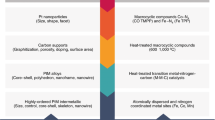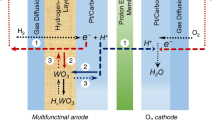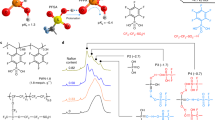Abstract
Fuel cells are the zero-emission automotive power source that best preserves the advantages of gasoline automobiles: low upfront cost, long driving range and fast refuelling. To make fuel-cell cars a reality, the US Department of Energy has set a fuel cell system cost target of US$30 kW−1 in the long-term, which equates to US$2,400 per vehicle, excluding several major powertrain components (in comparison, a basic, but complete, internal combustion engine system costs approximately US$3,000). To date, most research for automotive applications has focused on proton exchange membrane fuel cells (PEMFCs), because these systems have demonstrated the highest power density. Recently, however, an alternative technology, hydroxide exchange membrane fuel cells (HEMFCs), has gained significant attention, because of the possibility to use stable platinum-group-metal-free catalysts, with inherent, long-term cost advantages. In this Perspective, we discuss the cost profile of PEMFCs and the advantages offered by HEMFCs. In particular, we discuss catalyst development needs for HEMFCs and set catalyst activity targets to achieve performance parity with state-of-the-art automotive PEMFCs. Meeting these targets requires careful optimization of nanostructures to pack high surface areas into a small volume, while maintaining high area-specific activity and favourable pore-transport properties.
This is a preview of subscription content, access via your institution
Access options
Subscribe to this journal
Receive 12 print issues and online access
$259.00 per year
only $21.58 per issue
Buy this article
- Purchase on Springer Link
- Instant access to full article PDF
Prices may be subject to local taxes which are calculated during checkout



Similar content being viewed by others
References
Fuel Cell Technologies Office Multi-Year Research, Development, and Demonstration Plan Section 3.4 (US DOE, 2016).
Greene, D. L. & Duleep, G. Status and Prospects of the Global Automotive Fuel Cell Industry and Plans for Deployment of Fuel Cell Vehicles and Hydrogen Refueling Infrastructure (Office of Scientific and Technical Information, 2013).
Davis, P. Fuel Cell System Cost — 2002 vs 2005 DOE Hydrogen and Fuel Cells Program Record #5005 (US DOE, 2005).
James, B. D. Fuel Cell Vehicle and Bus Cost Analysis (2016); http://go.nature.com/2f6K2Qc
James, B. D., Moton J. M. & Colella, W. G Mass Production Cost Estimation of Direct H2 PEM Fuel Cell Systems for Transportation Applications: 2014 Update (US DOE, 2014).
Varcoe, J. R. et al. Anion-exchange membranes in electrochemical energy systems. Energy Environ. Sci. 7, 3135–3191 (2014).
Wang, Z., Parrondo, J. & Ramani, V. Alkaline stability of poly(phenylene oxide) based anion exchange membranes containing imidazolium cations. J. Electrochem. Soc. 163, F824–F831 (2016).
Zhang, B. Exploring Alkaline Stable Organic Cations for Polymer Hydroxide Exchange Membranes PhD thesis, Univ. Delaware (2015).
Xu, S., Jiang, R., Jiang, S. & Gao, Y. Communication—anion-conductive perfluoroheteroaromatic composite membranes: high chemical stability under strong alkaline conditions. J. Electrochem. Soc. 163, F688–F690 (2016).
Coms, F. D. The chemistry of fuel cell membrane chemical degradation. ECS Trans. 16, 235–255 (2008).
Stefánsson, A., Bénézeth, P. & Schott, J. Carbonic acid ionization and the stability of sodium bicarbonate and carbonate ion pairs to 200 °C — a potentiometric and spectrophotometric study. Geochim. Cosmochim. Acta 120, 600–611 (2013).
Kohl, P. A., Unlu, M. & Zhou, J. Anion exchange membrane fuel cells: experimental comparison of hydroxide and carbonate conductive ions. Electrochem. Solid-State Lett. 12, B27–B30 (2009).
Lu, S. F., Pan, J., Huang, A. B., Zhuang, L. & Lu, J. T. Alkaline polymer electrolyte fuel cells completely free from noble metal catalysts. Proc. Natl Acad. Sci. USA 105, 20611–20614 (2008).
Gu, S. et al. An efficient Ag-ionomer interface for hydroxide exchange membrane fuel cells. Chem. Commun. 49, 131–133 (2013).
Miller, H. A. et al. Pd/C-CeO2 anode catalyst for high-performance platinum-free anion exchange membrane fuel cells. Angew. Chem. Int. Ed. 128, 6108–6111 (2016).
Shinozaki, K., Zack, J. W., Richards, R. M., Pivovar, B. S. & Kocha, S. S. Oxygen reduction reaction measurements on platinum electrocatalysts utilizing rotating disk electrode technique: I. Impact of impurities, measurement protocols and applied corrections. J. Electrochem. Soc. 162, F1144–F1158 (2015).
Shinozaki, K., Zack, J. W., Pylypenko, S., Pivovar, B. S. & Kocha, S. S. Oxygen reduction reaction measurements on platinum electrocatalysts utilizing rotating disk electrode technique: II. Influence of ink formulation, catalyst layer uniformity and thickness. J. Electrochem. Soc. 162, F1384–F1396 (2015).
Kongkanand, A. & Mathias, M. F. The priority and challenge of high-power performance of low-platinum proton-exchange membrane fuel cells. J. Phys. Chem. Lett. 7, 1127–1137 (2016).
Nikolić, D. D. DAE Tools: equation-based object-oriented modelling, simulation and optimisation software. PeerJ Comput. Sci. 2, e54 (2016).
Zhuang, Z. et al. Nickel supported on nitrogen-doped carbon nanotubes as hydrogen oxidation reaction catalyst in alkaline electrolyte. Nat. Commun. 7, 10141 (2016).
Durst, J., Simon, C., Hasche, F. & Gasteiger, H. A. Hydrogen oxidation and evolution reaction kinetics on carbon supported Pt, Ir, Rh, and Pd electrocatalysts in acidic media. J. Electrochem. Soc. 162, F190–F203 (2014).
Chung, H. T., Won, J. H. & Zelenay, P. Active and stable carbon nanotube/nanoparticle composite electrocatalyst for oxygen reduction. Nat. Commun. 4, 1922 (2013).
Neyerlin, K. C., Gu, W. B., Jorne, J. & Gasteiger, H. A. Determination of catalyst unique parameters for the oxygen reduction reaction in a PEMFC. J. Electrochem. Soc. 153, A1955–A1963 (2006).
Liu, Y. X. et al. Proton conduction in PEM fuel cell cathodes: effects of electrode thickness and ionomer equivalent weight. J. Electrochem. Soc. 157, B1154–B1162 (2010).
Yu, Z. & Carter, R. N. Measurement of effective oxygen diffusivity in electrodes for proton exchange membrane fuel cells. J. Power Sources 195, 1079–1084 (2010).
Nonoyama, N., Okazaki, S., Weber, A. Z., Ikogi, Y. & Yoshida, T. Analysis of oxygen-transport diffusion resistance in proton-exchange-membrane fuel cells. J. Electrochem. Soc. 158, B416–B423 (2011).
Sheng, W. et al. Non-precious metal electrocatalysts with high activity for hydrogen oxidation reaction in alkaline electrolytes. Energy Environ. Sci. 7, 1719–1724 (2014).
Fuel Cell Technical Team Roadmap (US DRIVE Partnership, 2013); http://dx.doi.org/10.2172/1220127.
Sahraie, N. R. et al. Quantifying the density and utilization of active sites in non-precious metal oxygen electroreduction catalysts. Nat. Commun. 6, 8618 (2015).
Holby, E. F. & Zelenay, P. Linking structure to function: the search for active sites in non-platinum group metal oxygen reduction reaction catalysts. Nano Energy (in the press); http://dx.doi.org/10.1016/j.nanoen.2016.05.025.
Garsany, Y., Ge, J., St-Pierre, J., Rocheleau, R. & Swider-Lyons, K. E. Analytical procedure for accurate comparison of rotating disk electrode results for the oxygen reduction activity of Pt/C. J. Electrochem. Soc. 161, F628–F640 (2014).
Suntivich, J., Gasteiger, H. A., Yabuuchi, N. & Shao-Horn, Y. Electrocatalytic measurement methodology of oxide catalysts using a thin-film rotating disk electrode. J. Electrochem. Soc. 157, B1263–B1268 (2010).
Serov, A., Artyushkova, K., Andersen, N. I., Stariha, S. & Atanassov, P. Original mechanochemical synthesis of non-platinum group metals oxygen reduction reaction catalysts assisted by sacrificial support method. Electrochim. Acta 179, 154–160 (2015).
Zelenay, P. Non-Precious Metal Fuel Cell Cathodes: Catalyst Development and Electrode Structure Design (2013); http://go.nature.com/2eMPMTN
Durst, J. et al. New insights into the electrochemical hydrogen oxidation and evolution reaction mechanism. Energy Environ. Sci. 7, 2255–2260 (2014).
Woodroof, M. D., Wittkopf, J. A., Gu, S. & Yan, Y. S. Exchange current density of the hydrogen oxidation reaction on Pt/C in polymer solid base electrolyte. Electrochem. Commun. 61, 57–60 (2015).
Mahoney, E. G. The Development of Supported Electrocatalysts for the Oxidation of Fuels in Hydroxide Exchange Membrane Fuel Cells PhD thesis, Univ. Delaware (2015).
Kaspar, R. B., Wittkopf, J. A., Woodroof, M. D., Armstrong, M. J. & Yan, Y. Reverse-current decay in hydroxide exchange membrane fuel cells. J. Electrochem. Soc. 163, F377–F383 (2016).
Kiros, Y., Majari, M. & Nissinen, T. A. Effect and characterization of dopants to Raney nickel for hydrogen oxidation. J. Alloys Compd 360, 279–285 (2003).
Wang, Y. et al. Pt–Ru catalyzed hydrogen oxidation in alkaline media: oxophilic effect or electronic effect? Energy Environ. Sci. 8, 177–181 (2015).
Park, S.-A., Lim, H. & Kim, Y.-T. Enhanced oxygen reduction reaction activity due to electronic effects between Ag and Mn3O4 in alkaline media. ACS Catal. 5, 3995–4002 (2015).
Alia, S. M., Duong, K., Liu, T., Jensen, K. & Yan, Y. Supportless silver nanowires as oxygen reduction reaction catalysts for hydroxide-exchange membrane fuel cells. ChemSusChem 5, 1619–1624 (2012).
Alia, S. M., Yan, Y. & Pivovar, B. Galvanic displacement as a route to highly active and durable, extended surface electrocatalysts. Catal. Sci. Technol. 4, 3589–3600 (2014).
Alia, S. M. et al. Porous platinum nanotubes for oxygen reduction and methanol oxidation reactions. Adv. Funct. Mater. 20, 3742–3746 (2010).
Carlson, E. J., Kopf, P., Sinha, J., Sriramulu, S. & Yang, Y. Cost Analysis of PEM Fuel Cell Systems for Transportation (NREL, 2005).
Varcoe, J. R. et al. Anion-exchange membranes in electrochemical energy systems. Energy Environ. Sci. 7, 3135–3191 (2014).
Sheng, W. C., Gasteiger, H. A. & Shao-Horn, Y. Hydrogen oxidation and evolution reaction kinetics on platinum: acid vs alkaline electrolytes. J. Electrochem. Soc. 157, B1529–B1536 (2010).
Wiberg, G. K. H., Mayrhofer, K. J. J. & Arenz, M. Investigation of the oxygen reduction activity on silver — a rotating disc electrode study. Fuel Cells 10, 575–581 (2010).
Acta 4020 Cathode Catalyst Datasheet (Acta S.p.A, 2016).
Elbert, K. et al. Elucidating hydrogen oxidation/evolution kinetics in base and acid by enhanced activities at the optimized Pt shell thickness on the Ru core. ACS Catal. 5, 6764–6772 (2015).
Zheng, J., Sheng, W., Zhuang, Z., Xu, B. & Yan, Y. Universal dependence of hydrogen oxidation and evolution reaction activity of platinum-group metals on pH and hydrogen binding energy. Sci. Adv. 2, 1–8 (2016).
Zheng, J., Zhuang, Z., Xu, B. & Yan, Y. Correlating hydrogen oxidation/evolution reaction activity with the minority weak hydrogen-binding sites on Ir/C catalysts. ACS Catal. 5, 4449–4455 (2015).
Zheng, J., Zhou, S., Gu, S., Xu, B. & Yan, Y. Size-dependent hydrogen oxidation and evolution activities on supported palladium nanoparticles in acid and base. J. Electrochem. Soc. 163, F499–F506 (2016).
Owejan, J. P., Owejan, J. E. & Gu, W. Impact of platinum loading and catalyst layer structure on PEMFC performance. J. Electrochem. Soc. 160, F824–F833 (2013).
Li, W., Waje, M., Chen, Z., Larsen, P. & Yan, Y. Platinum nanopaticles supported on stacked-cup carbon nanofibers as electrocatalysts for proton exchange membrane fuel cell. Carbon N. Y. 48, 995–1003 (2010).
Leonard, N. D. et al. Modeling of low-temperature fuel cell electrodes using non-precious metal catalysts. J. Electrochem. Soc. 162, 1253–1261 (2015).
Serov, A., Robson, M. H., Artyushkova, K. & Atanassov, P. Templated non-PGM cathode catalysts derived from iron and poly(ethyleneimine) precursors. Appl. Catal. B Environ. 127, 300–306 (2012).
Hao, G.-P. et al. Hydrophilic non-precious metal nitrogen-doped carbon electrocatalysts for enhanced efficiency in oxygen reduction reaction. Chem. Commun. 51, 17285–17288 (2015).
Acknowledgements
The work was supported in part by the US Department of Energy ARPA-E Program (DE-AR0000009).
Author information
Authors and Affiliations
Corresponding author
Ethics declarations
Competing interests
The authors declare no competing financial interests.
Rights and permissions
About this article
Cite this article
Setzler, B., Zhuang, Z., Wittkopf, J. et al. Activity targets for nanostructured platinum-group-metal-free catalysts in hydroxide exchange membrane fuel cells. Nature Nanotech 11, 1020–1025 (2016). https://doi.org/10.1038/nnano.2016.265
Received:
Accepted:
Published:
Issue Date:
DOI: https://doi.org/10.1038/nnano.2016.265
This article is cited by
-
Metal-support interaction boosts the stability of Ni-based electrocatalysts for alkaline hydrogen oxidation
Nature Communications (2024)
-
Tuning the apparent hydrogen binding energy to achieve high-performance Ni-based hydrogen oxidation reaction catalyst
Nature Communications (2024)
-
Synergistic interactions between PtRu catalyst and nitrogen-doped carbon support boost hydrogen oxidation
Nature Catalysis (2023)
-
High-performance ionomerless cathode anion-exchange membrane fuel cells with ultra-low-loading Ag–Pd alloy electrocatalysts
Nature Energy (2023)
-
Revealing the role of double-layer microenvironments in pH-dependent oxygen reduction activity over metal-nitrogen-carbon catalysts
Nature Communications (2023)



